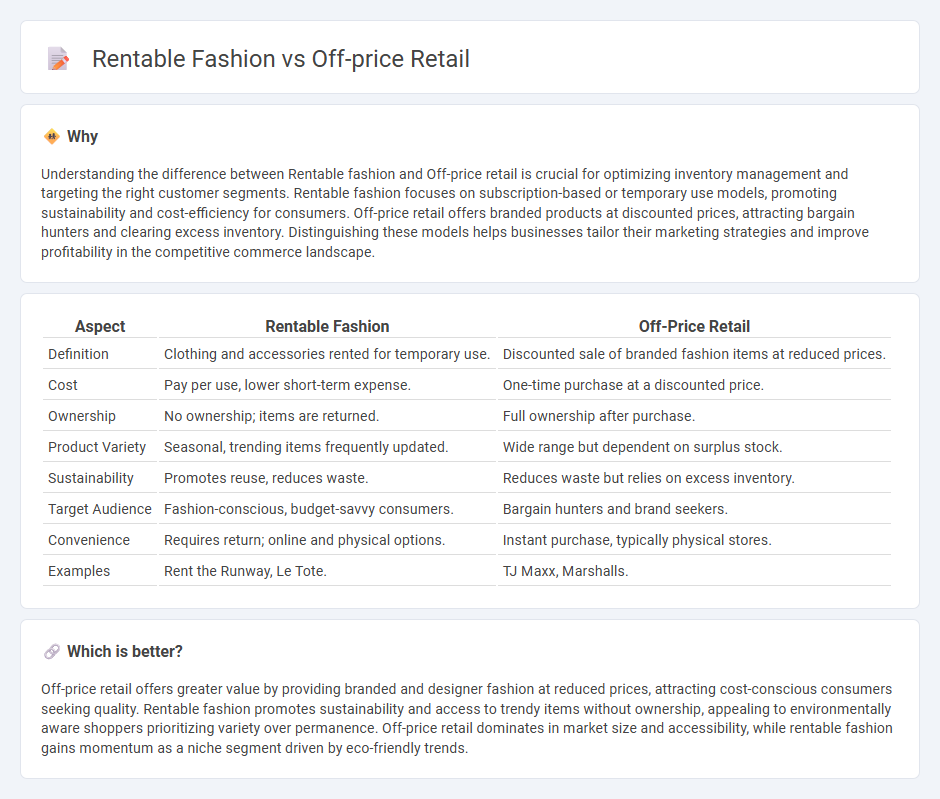
Rentable fashion offers consumers access to high-end apparel through subscription or rental services, enabling variety and sustainability without full ownership. Off-price retail provides discounted brand-name clothing and accessories, attracting bargain hunters seeking authentic products at reduced prices. Explore deeper insights into how these models transform consumer behavior in the fashion industry.
Why it is important
Understanding the difference between Rentable fashion and Off-price retail is crucial for optimizing inventory management and targeting the right customer segments. Rentable fashion focuses on subscription-based or temporary use models, promoting sustainability and cost-efficiency for consumers. Off-price retail offers branded products at discounted prices, attracting bargain hunters and clearing excess inventory. Distinguishing these models helps businesses tailor their marketing strategies and improve profitability in the competitive commerce landscape.
Comparison Table
| Aspect | Rentable Fashion | Off-Price Retail |
|---|---|---|
| Definition | Clothing and accessories rented for temporary use. | Discounted sale of branded fashion items at reduced prices. |
| Cost | Pay per use, lower short-term expense. | One-time purchase at a discounted price. |
| Ownership | No ownership; items are returned. | Full ownership after purchase. |
| Product Variety | Seasonal, trending items frequently updated. | Wide range but dependent on surplus stock. |
| Sustainability | Promotes reuse, reduces waste. | Reduces waste but relies on excess inventory. |
| Target Audience | Fashion-conscious, budget-savvy consumers. | Bargain hunters and brand seekers. |
| Convenience | Requires return; online and physical options. | Instant purchase, typically physical stores. |
| Examples | Rent the Runway, Le Tote. | TJ Maxx, Marshalls. |
Which is better?
Off-price retail offers greater value by providing branded and designer fashion at reduced prices, attracting cost-conscious consumers seeking quality. Rentable fashion promotes sustainability and access to trendy items without ownership, appealing to environmentally aware shoppers prioritizing variety over permanence. Off-price retail dominates in market size and accessibility, while rentable fashion gains momentum as a niche segment driven by eco-friendly trends.
Connection
Rentable fashion leverages off-price retail strategies by offering designer and high-quality apparel at reduced costs through leasing models, maximizing consumer access while minimizing inventory risks. Off-price retail channels provide the supply chain foundation for rentable fashion by sourcing surplus or past-season merchandise, enabling sustainable and cost-effective inventory turnover. This synergy enhances profitability in commerce by combining affordability, variety, and environmental consciousness, attracting budget-savvy and eco-conscious consumers.
Key Terms
Inventory sourcing
Off-price retail relies heavily on surplus inventory from brands, securing high-quality products at discounted rates for rapid turnover. Rentable fashion platforms emphasize curated collections sourced through partnerships with designers and wholesalers, focusing on freshness and trend relevance rather than inventory volume. Explore detailed strategies behind inventory sourcing in both models to understand their market impact.
Pricing strategy
Off-price retail leverages deep discounts by selling excess or out-of-season inventory, targeting price-sensitive customers through reduced price points often 20-70% below regular retail. Rentable fashion employs dynamic pricing based on item popularity, rental duration, and subscription models, offering customers affordable access to trending apparel without ownership costs. Explore the evolving pricing strategies in these sectors to understand their impact on consumer behavior and profitability.
Consumer access
Off-price retail offers consumers discounted brand-name fashion products through surplus inventory and closeout sales, enabling budget-conscious shoppers to access trendy items at reduced prices. Rentable fashion provides an alternative model where consumers can access high-quality, designer clothing and accessories temporarily, promoting sustainability and flexibility without the commitment of ownership. Explore the evolving consumer benefits and market dynamics of off-price retail versus rentable fashion to understand which model best suits your lifestyle.
Source and External Links
Off-Price - Salsify - Off-price retailing is a model where businesses sell branded goods at significant discounts--typically 40-60% off full price--to clear excess inventory or respond to market changes, benefiting both retailers and customers seeking value.
Study Finds Opening 'Off-Price' Stores Increases Online Shopping for High-End Retailers - When high-end retailers open off-price stores like Nordstrom Rack or Saks Off Fifth, customer spending shifts from flagship stores to online channels, reflecting changing shopping behaviors in response to discounted branded offerings.
The Secret Behind Off-Price Retail Success - Chute Gerdeman - Off-price retailers such as TJX succeed by offering quality merchandise at lower prices, leveraging real-time inventory management, robust loyalty programs, and enhanced mobile apps to attract value-conscious and sustainability-minded shoppers.
 dowidth.com
dowidth.com